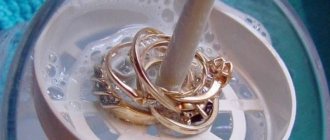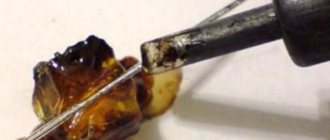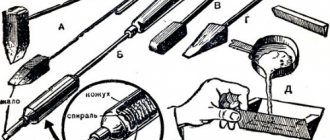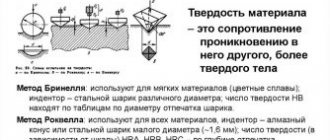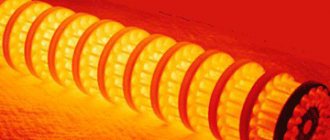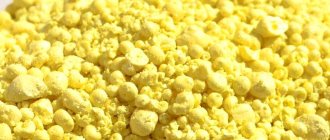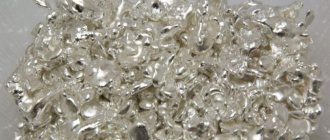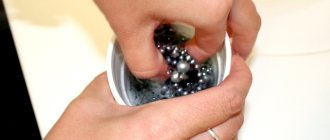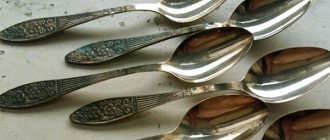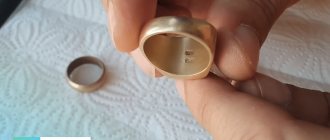Stamp and hallmark
Products made from pure silver are visually beautiful, but are not practical. Due to the increased ductility of the metal, the product quickly ceases to shine in the absence of constant cleaning.
In the jewelry industry, alloys of various metals have long been used to increase the strength of products. To distinguish by the amount of additives added, a sample is applied to the jewelry.
An example of a sample on a silver ring.
A test (a stamp showing the content of impurities in silver) is placed on the inside of the product. Fineness - three numbers indicating the silver content in one kilogram of the alloy. For example, standard 925 means that 1 kg contains 75 grams of impurities and 925 grams of pure metal.
Samples of silver items:
| Try | Characteristics |
| 720 | Low standard silver, copper impurity. The most durable silver alloy used in industrial applications. Jewelry is not made from such silver, so it is inappropriate to undergo an assay inspection here. |
| 800, 830 | Production of silver cutlery. |
| 875 | “White gold” - contains no gold. Only silver and copper. |
| 916 | The alloy of this hallmark was used in the Soviet Union in the manufacture of silverware (not currently used in the jewelry industry). |
| 925 | Silver jewelry. |
| 960 | An alloy close to natural metal, soft and easily deformable (used to create relief compositions). |
| 999 | Pure silver, it is used to create collectible coins and bars (used in medicine and industry). |
Jewelry silver
Jewelry silver is used in making jewelry. In ancient times, it had a higher value compared to gold. Its distinguishing feature from other types of metal is its impurities. In its pure form, it has a very high softness, which is inconvenient for making jewelry and not practical for wearing. Only technical silver is used in its pure form. Copper is most often added to argentum. Copper increases the wear resistance and strength of products. However, its significant drawback is oxidation. Because of this, silver jewelry with the addition of copper quickly darkens. Other impurities used are nickel, zinc, aluminum and cadmium. Nickel can cause allergies. But adding cadmium will significantly increase the cost of the product. Since it itself is an expensive metal. Any piece of jewelry made from argentum must be stamped indicating the purity. As a rule, this is 925 standard, however, 875, 916, 960 standard are also considered high-quality alloys.
Iodine
A drop of iodine and the product being tested are required. Iodine reacts chemically with silver. The process is accompanied by darkening at the point of contact between iodine and silver. The mark from a reaction to iodine is very difficult to remove, so the method is not very good. It is better to conduct the experiment on the inside of the object.
Reaction of silver to iodine.
- A drop of iodine on real silver will leave a dark stain.
- Iodine does not react with other metals. The surface where iodine was applied will remain unchanged.
Iodine stains are difficult to remove! Be careful, check from the inside of the products.
At home, it is not possible to determine the sample and silver-plated products. Aluminum and copper blanks coated with a thin layer of silver are often found. Iodine will leave a mark on such products, but the silver content cannot be determined in this way.
Testing with iodine is one of the effective methods for identifying fake silver at home. The remaining methods are more suitable for self-soothing or are less accessible for self-checking.
Vinegar
You can test silver with vinegar.
Pour the 9% table bite solution into a bowl and lower the product into the container for a few seconds. Since silver is a low-reactive metal, it will not react with vinegar. If a white coating appears on the product or other changes occur, this is a fake.
You can use a bite to clean silverware and dishes until they shine.
Store tests for silver (chrompic)
You can purchase a test to check metal in pharmacies or special retail outlets.
To use the reagent correctly, read the instructions and carry out simple manipulations. Before starting the experiment, you should wipe the selected area with a file or run the product over a stone made of silicon slate (so as not to spoil the appearance of the product) and treat it with a reagent. After a certain period of time, you can assess the condition of the metal by the color of the developed trace:
A drop of a special tester turned red - real silver (right). Has not changed color - fake.
Sulfur ointment, nitric acid, whiteness
The principle of testing is the same as when testing with iodine. We apply a drop of the reagent to the product, wait and see if the product reacts to the drugs:
- A real silver item will show tarnish where the substances were applied.
- Nothing will happen on a fake.
Reaction to chemical exposure.
Blackened silver
Blackening is a type of metal coating that is achieved by melting lead, copper and silver sulfide oxides. The niello, spreading over the surface of the product, colors it black and creates patterns. Not a single blackened decoration is similar to another. Blackening also increases the durability of the product, because it does not require cleaning.
There is also a metal coating method called oxidation. Externally, it is very similar to blackening. But the blackening process is more complex and the resulting product is more expensive.
Oxidation is the use of potassium sulfide, which causes corrosion or darkening of the surface of the jewelry.
Blackening is a more complex process, in which, in addition to silver, copper and lead are also used. An alloy is melted into the cut out parts of the jewelry, which creates an additional layer on the product.
Oxidation is a less energy-consuming and expensive process compared to blackening.
Magnet
You can check silver at home without any marks on the metal. A regular magnet is used for this. The reaction to the magnet will indicate a fake:
Magnetic testing - detection of gross fakes.
- A product made of real silver does not attach to a magnet.
- Fake ferrous metals will stick to the magnet.
Do not check chain locks with a magnet. The locks have a mechanism that responds to a magnet.
The method is very popular, but not very accurate; non-ferrous metals do not always react to a magnet.
Technical silver
Hearing the word “technical” in the name, one may mistakenly assume that this is a low-quality metal that is not used for the manufacture of something important. However, this is not at all true. It is this type of metal that has the purest alloy. The share of impurities here is only 0.1%, the remaining 99.9% is pure argentum.
Accordingly, technical silver has the highest standard of 999. Technical silver faces serious challenges. It is used for the manufacture of wires, contacts, radio components, and auto parts. Among other varieties, it is characterized by high electrical conductivity and light reflection.
Despite its value and high quality, such silver cannot be worn on the body. It sometimes contains impurities of nickel, lead, tin, aluminum or copper. Nickel is a strong allergen. Lead tends to accumulate in the body and cause harm over time. Other impurities are safe.
Thermal method
One of the properties of silver is thermal conductivity, due to which the metal quickly heats up to ambient temperature. If you hold the product in your hand, it will almost immediately heat up to body temperature. When immersed in cold or hot water, the metal will quickly return to the same temperature.
Boiling water is a good way to test the quality of a silver alloy. When removed from a hot product, it burns the skin and quickly cools to room temperature. Fake silver removed from boiling water will be lukewarm.
How to distinguish silver from cupronickel
- A silver product contains a hallmark; a mark with the MNC symbols means cupronickel.
A distinctive feature of cupronickel cutlery. - Cupronickel can be recognized using ordinary water. You should pour it into a container and place the product there. After a short period of time, greenery will appear on things made from cupronickel, but silver will not change its shade.
- Cupronickel can be identified by its smell; it is characterized by the usual smell of copper. To make the aroma stronger, you can rub the object of study.
- You can run a lapis pencil over the moistened surface of the object. A silver product will not show a reaction, but a dark spot will appear on cupronickel. If there is a suspicion that cupronickel is covered with a thin silver layer, you need to find the worn place and repeat the manipulations.
- Items made of cupronickel weigh much lighter than silver ones.
- Metal can be tested using iodine. A drop of the substance on an item placed in sunlight will show a dark spot on the silver. The trace is extremely difficult to remove, so you need to find an inconspicuous place for the experiment.
- One of the surest options would be to take the product to a jewelry workshop, where they will determine exactly what it is made of.
Radiant silver
Radiated silver is a metal coated with radium. Not to be confused with rhodium plating. This is rhodium plated. These two consonant names of Argentum species have a large number of differences. The fact is that radium is a radioactive chemical element and is contraindicated for use in jewelry. This is a highly toxic element that can harm the human body.
The discovery of radium by Pierre and Marie Curie played an important role in history. Today radium is used in the fight against malignant tumors. Radon baths help in the treatment of diseases of the musculoskeletal system. The word radium is of Latin origin “radius” and means ray. When combined with other substances, radium is capable of producing light. Therefore, it is widely used in the manufacture of paints for road markings or runways. Radium, like silver, is widely used in the technical and medical fields. Until the 60-70s of the last century, silver parts coated with radium were widely used in watches, compasses, aircraft instruments, and instruments for physical measurements.
Video
How silver is determined for authenticity, how the sample is recognized in jewelry workshops. How to use special chemical liquids and analyzer:
Large video test of various metal products (aluminum, copper, chrome, stainless steel, silver) for the reaction of sulfur ointment. How to test silver at home video:
To protect yourself from purchasing a fake, it is better to purchase silver jewelry in jewelry stores. Here, upon request, the seller is obliged to present certificates of product quality. The likelihood of purchasing low-quality silver will be minimal.
